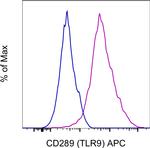Search Thermo Fisher Scientific
Invitrogen
CD289 (TLR9) Monoclonal Antibody (M9.D6), APC, eBioscience™
FIGURE: 1 / 1
CD289 (TLR9) Antibody (17-9093-82) in Flow

Product Details
17-9093-82
Species Reactivity
Host/Isotype
Recommended Isotype Control
Class
Type
Clone
Immunogen
Conjugate
Excitation/Emission Max
Form
Concentration
Purification
Storage buffer
Contains
Storage conditions
Shipping conditions
RRID
Product Specific Information
Description: M9.D6 is generated against a peptide derived from the extracellular portion of mouse TLR9. Predominantly expressed as an intracellular protein, TLR9 is a ~115-120 kDa molecule which mediates response to unmethylated CpG dinucleotides in bacterial DNA. CpG DNA induces a strong T-helper-1-like inflammatory response and the proliferation of TLR9+ B cells. When stimulated with CpG DNA, TLR9-deficient (TLR9-/-) mice lacked splenocyte proliferation, inflammatory cytokine production from macrophages, and dendritic cell maturation, as compared with normal mice. To date, at least ten members of the Toll family have been identified. This family of type I transmembrane proteins is characterized by an extracellular domain with leucine-rich repeats and a cytoplasmic domain with homology to the type I IL-1 receptor. Members of the TLR family are involved in recognition and response to different microbial components including lipoproteins, peptidoglycans, and nucleic acids and play important roles in innate immunity and inflammation. TLR9 is not detected by flow cytometry using this antibody on RBC-lysed mouse splenocytes stained for intracellular TLR9. This may be due to limitations of antigen detection by flow cytometry. Further studies are needed to determine the relationship between mRNA expression and protein detection.
Applications Reported: This M9.D6 antibody has been reported for use in intracellular flow cytometric analysis.
Applications Tested: This M9.D6 antibody has been tested by flow cytometric analysis of mouse TLR9 transfected 293T cells using the Intracellular Fixation & Permeabilization Buffer Set (Product # 88-8824-00) and protocol. Please refer to "Staining Intracellular Antigens for Flow Cytometry, Protocol A: Two step protocol for intracellular (cytoplasmic) proteins" located at www.thermofisher.com/flowprotocols . This may be used at less than or equal to 1.0 µg per test. A test is defined as the amount (µg) of antibody that will stain a cell sample in a final volume of 100 µL. Cell number should be determined empirically but can range from 10^5 to 10^8 cells/test. It is recommended that the antibody be carefully titrated for optimal performance in the assay of interest.
Excitation: 633-647 nm; Emission: 660 nm; Laser: Red Laser.
Target Information
The protein encoded by this gene is a member of the Toll-like receptor family which plays a fundamental role in pathogen recognition and activation of innate immunity. TLRs are highly conserved from Drosophila to humans and share structural and functional similarities. They recognize pathogen-associated molecular patterns that are expressed on infectious agents, and mediate the production of cytokines necessary for the development of effective immunity. The various TLRs exhibit different patterns of expression. This gene is preferentially expressed in immune cell rich tissues, such as spleen, lymph node, bone marrow and peripheral blood leukocytes. Studies in mice and human indicate that this receptor mediates cellular response to unmethylated CpG dinucleotides in bacterial DNA to mount an innate immune response.
For Research Use Only. Not for use in diagnostic procedures. Not for resale without express authorization.
How to use the Panel Builder
Watch the video to learn how to use the Invitrogen Flow Cytometry Panel Builder to build your next flow cytometry panel in 5 easy steps.
References (0)
Bioinformatics
Protein Aliases: CD289; Toll-like receptor 9
Gene Aliases: Tlr9
UniProt ID: (Mouse) Q9EQU3
Entrez Gene ID: (Mouse) 81897

Performance Guarantee
If an Invitrogen™ antibody doesn't perform as described on our website or datasheet,we'll replace the product at no cost to you, or provide you with a credit for a future purchase.*
Learn more
We're here to help
Get expert recommendations for common problems or connect directly with an on staff expert for technical assistance related to applications, equipment and general product use.
Contact tech support

